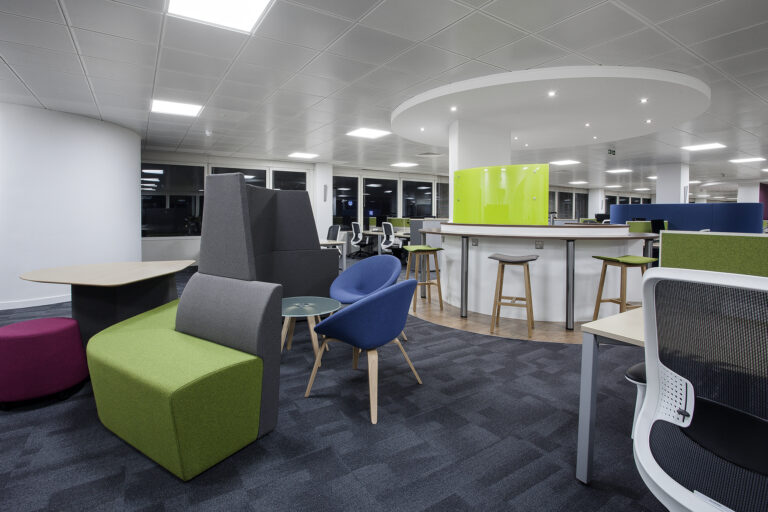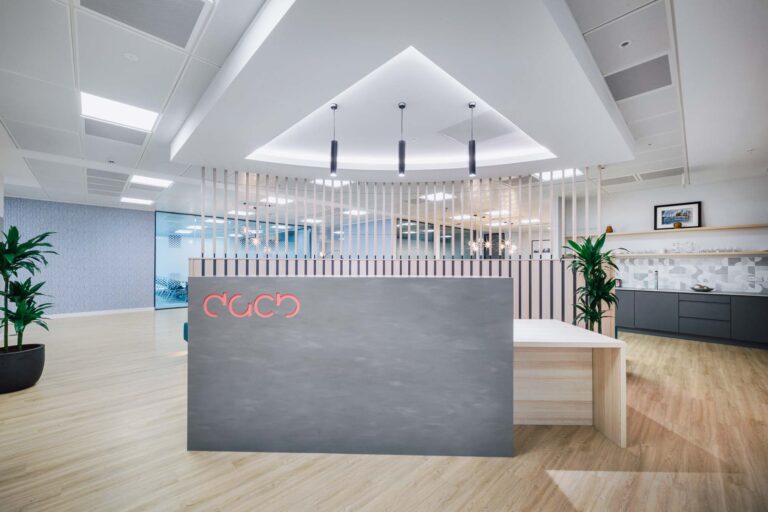
Does your law firm have a future-ready workplace?
Date
5 March 2024
Read length
5 min
In a recent issue of Briefing magazine their was an insightful interview with legal firms Clyde & Co and Freeths where they discussed how workplace transformation is enabling them to adapt and prepare for the future. Take a look at our top 8 interior design considerations for creating a future-ready workplace for a future-ready law firm.
Earlier this month, Briefing magazine published an insightful interview with senior leaders from legal firms Clyde & Co and Freeths about how workplace transformation is enabling them to adapt and prepare for the future.
In the piece, Freeths’ national managing partner, Karl Jansen, talked about how their firm was bucking the trend by taking additional space to accommodate growth, explaining that it was less space than they would have taken in a ‘pre-hybrid world’. He also championed the value of the Destination Office – a concept we’re heavily behind – and the business benefits of time spent together.
Clyde & Co’s chief sustainability officer, Paddy Linighan, highlighted the importance of sustainable buildings and renewable energy for legal firms and shared Clyde & Co’s goal to reduce its office capacity by 45% by 2025. He also noted some of the cultural benefits of moving its Belfast team into a more open-plan workspace.
Simon Campion, Director from Claremont, said: “The experiences and insights that Freeths and Clyde & Co shared in the article are indicative of what we hear from the legal sector as a whole.
“There’s a strong desire among legal firms to think differently and to make office space do something more strategic and powerful for their people and businesses, but it’s not without its challenges. Many legal firms are unsure how much office space they need in light of hybrid working. They’re also grappling with the need for greater sustainability, how to achieve better inclusion and diversity and the introduction of AI and other technologies, which are profoundly affecting how they work.
“Each of these challenges is significant in its own right, but together, they highlight why legal firms need workplaces that are up for the task. Legal office interior design needs to support changes to how work is done, meet employees’ shifting expectations and flex as the business does. Quite simply, future-ready law firms need a future-ready workplace.”
As a result, we’ve compiled our top eight office interior design considerations for creating a future-ready workplace for law firms:
1. Sustainable design – Today’s employees are environmentally savvy and want to see their employers actively adopt greener ways of doing business. This has to go beyond offering recycling or reducing energy consumption to include occupying sustainable buildings and ensuring sustainable office fit-outs. Examples include avoiding waste when approaching workplace transformation by working with Cat A fit-outs rather than ripping them out to start again, re-using existing furniture, choosing sustainable materials when new items are required and introducing energy-efficient technologies such as rainwater harvesting and intelligent building controls.
2. Community-focused – Remote working is now commonplace in the legal sector, but firms still need to maintain a sense of community and culture, as Clyde & Co point out in the article. Future-ready workplaces engender culture and offer the face-to-face experiences that remote work can’t deliver. Inspiring teamwork spaces fitted out with the latest collaboration tech, well-designed cafes and social spaces, and dedicated training spaces for peer-to-peer training and learning are some ways the workplace can deliver.
3. Inclusive – The opposite of inclusion is exclusion. Legal firms can’t afford to exclude valuable parts of the talent pool. Inclusive workplaces acknowledge and cater for the needs of a variety of users, such as those experiencing menopause, with religious requirements or who have neurodivergent needs, and offer choices so everyone can participate in their own way.
4. Intuitive – Employees want frictionless workplaces and intuitive spaces that are easy to use. That means actively looking at barriers to productivity and functionality and removing them. Examples include using room management systems so people can book meeting rooms as required, offering concierge-style IT support, and specifying furniture with built-in charging and power points.
5. Flexible – The pandemic taught us that things can change quickly, so it’s unsurprising that legal firms seek greater flexibility in their workplaces. This can mean making different office fit-out choices, such as opting for movable furniture pods instead of partition walls, creating open-plan spaces with dual purposes and using intelligent building technology to decommission parts of the office on quieter days. Flexibility is now the holy grail of the legal workplace.

6. Feelings – Face with a global shortage of talent and a highly competitive recruitment market, legal firms need to ensure they’re creating desirable workplace experiences by meeting their employees’ emotional and mental needs. To do that, you have to know how employees want to feel. The Workplace Oooh research we commissioned last year revealed the six feelings that are most important to employees – they want to feel inspired, valued, connected, supported, included and proud. It’s the job of the workplace, the culture it houses and the facilities it offers to give employees these positive feelings.
7. Choice – Choice-led workspaces empower employees and help hybrid workers retain the sense of control they have when working from home. Choice-led workplaces make it easy for employees to work as they see fit, thanks to various activity-based work settings and zones. Not everyone will want or need a desk for a whole day; they might want to work from a breakout space or to be in a quiet, tech-free space to aid concentration. Others might want to work from the bustling on-site café or to take some time away from their work in a wellbeing space.
8. Destination – To make the workplace desirable, you must create value for its users. This means not leaving employees’ experiences to chance and instead curating positive and memorable ones. 84%[1] of employees want the office to deliver an experience rather than just being a place to complete tasks. Value can be delivered in the workplace by hosting company-wide and team events, allowing employees to learn fun new skills with colleagues at lunch or participate in peer-to-peer mentoring. By prioritising people’s holistic needs, legal firms can create workplaces that employees actively choose to visit. (Learn about the key components of the Destination Office here)
Our legal expertise
From creating hybrid-ready HQs to transforming heritage buildings into modern legal hubs, we’ve worked with some of the UK’s most prestigious law firms to provide them with a future-ready workplace. Download our legal credentials and explore all of our work in the sector here!
You can read the full article in Briefing here.
[1] Data compiled as part of Claremont’s 2023 study, The Workplace Oooh.
See how we could help with your new office interior design or office design and build project here
Get in touch
We love nothing better than talking all things workplace and design – got a question, potential project or just need some guidance?
Drop us a note…






